SEO
Everything You Need To Know About Cloudflare For SEO
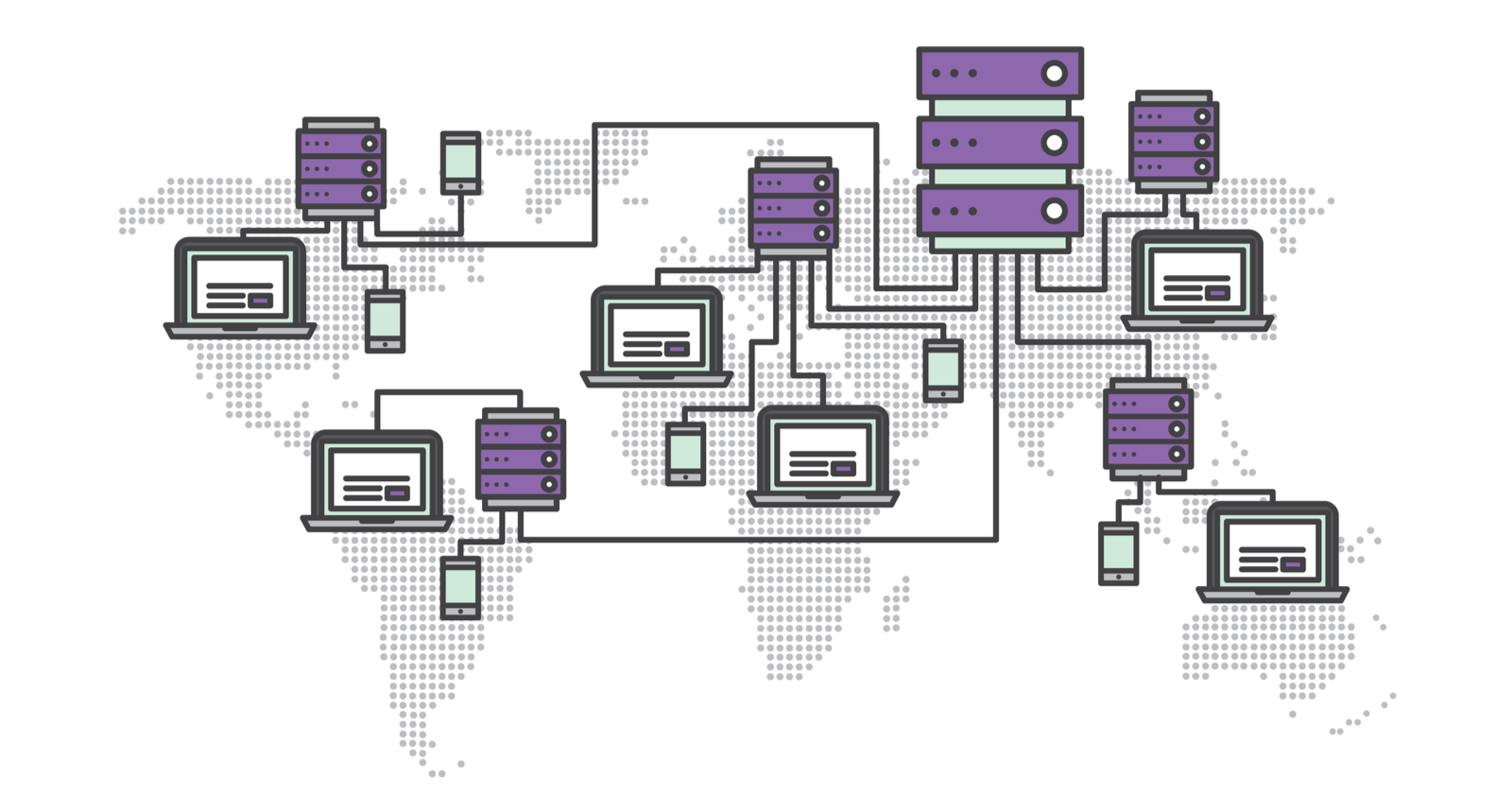
Maybe you’ve heard of Cloudflare in your SEO wanderings. But even among those familiar with the name, many don’t know know how it really works.
Some think that the platform is nothing more than another DNS management system.
However, I can confidently say that the platform offers exceptional features for:
- SEO security.
- DDoS protection.
- Speed optimization.
If you haven’t had the time to learn how Cloudflare can improve your SEO, this guide covers multiple feature implementations that can supercharge your search engine optimization in the next few pages.
(Disclosure: I’m a Cloudflare certified partner. This article is based on my 20+ years of experience in enterprise SEO and familiarity with the platform; I’ve received no compensation for writing this.)
Wait. What Is Cloudflare If It’s Not A DNS Management System?
Cloudflare started as a DNS management tool but has since expanded into a tool for:
- DNS management.
- Security.
- Caching.
- Website optimization (more on that below).
- Bot Management.
- WAF.
- So much more.
If you dig into the company, they call themselves a “web performance and security company.”
And through a global network, they’ve been able to offer fast, private, and secure features that can help you keep your site fast and secure.
Plus, the company has been rapidly adding features that show the power of running Cloudflare in the background of your website.
For example, one of the major announcements at the end of October 2021 was that IndexNow had become a thing. Microsoft and Yandex have both pushed IndexNow, an open-source protocol that allows you to tell search engines to instantly index your pages.
Cloudflare partnered with Microsoft, and the two announced that 60,000 websites have opted into the Crawler Hints feature.
Essentially, the feature, which is part of Cloudflare’s platform, tells Bing that you have new website assets that need to be crawled.
The protocol works so well that Google has said they’re going to test it to see whether it’s something they may integrate into their search engine.
As anyone in the SEO field will tell you, instant indexing is a complete game-changer for site owners.
With that context under your belt, let’s take a look at how Cloudflare can improve your SEO and how to use some of its features.
Cloudflare Features That Can Improve Your SEO
Security-Related Features
- SSL/TLS.
- Firewall.
- Bot Management.
- WAF.
- Captcha.
Performance-Related Features
- CDN.
- Caching.
- Code Minify.
- Image Optimization.
- Redirects.
Security-Related Features
Do you know any SEOs who are security experts? Of course, you take on many roles when working on a site’s optimization, but there are a lot of security aspects that are simply out of your wheelhouse.
Cloudflare can help you bridge the security gap to improve user experience and site security with the following features:
SSL/TLS
Data security is at the forefront of consumers’ minds. In 2019, over 15 billion records leaked due to eCommerce data theft.
Cloudflare offers SSL free of charge to encrypt a user’s web data and even boosts SEO through:
- Faster page load times.
- Google’s favor towards HTTPS sites.
A site needs to use SSL/TLS to be PCI compliant and trusted by users.
Cloudflare offers numerous configuration options, including custom certificates, modern TLS only, HSTS, automatic HTTPS rewrites, and much more.
Firewall
Firewalls help you control web traffic and who can access your site.
Through HTML filtering and fine-grained controls, developers can use Cloudflare to manage rules, control bots, show captcha codes, create custom expressions for advanced rule setups, and much more.
Using firewalls makes it possible to keep your site safe and secure with precision rules.
Bot Management
 Screenshot from Cloudflare, December 2021
Screenshot from Cloudflare, December 2021Bots slow up a website and leave spam wherever they go.
Additionally, bots can steal information and damage your brand. Through real-time monitoring, it’s possible to keep bots from infesting your site through Cloudflare’s:
- Behavioral analysis.
- Machine learning.
- Bot scoring.
Cloudflare can stop bots from DDoS-ing your site, scraping your content, and spamming content, too.
If you’re running a major content marketing strategy, preventing bots from scraping your site can lead to better SEO rankings since bots won’t be reposting the content everywhere.
WAF
If you’re working on an enterprise site, there’s a good chance that they use APIs and applications. A WAF is a web application firewall that integrates into these growth tools to offer:
- OWASP rule adherence.
- Managed rules.
- Monitoring of stolen and exposed data.
- Custom response options.
- Much more.
While a WAF may not offer direct SEO benefits, it will keep applications and APIs safe and secure.
Captcha
Do you hate captcha codes? Everyone does.
Cloudflare helps you reduce the time it takes to solve captchas down to five seconds with the introduction of Cryptographic Attestation of Personhood.
Instead of captcha codes, you can add a new layer of security to your website while also eliminating the concern of bots on your site.
Performance-Related Features
Speed and performance are integral to technical search engine optimization. This demands a speedy site, and Cloudflare helps you meet these performance needs through the following:
CDN
If you’re not already using a content delivery network (CDN), you need to start. Cloudflare has an extensive global edge delivery network that allows you to:
- Reduce bandwidth costs.
- Protect against DDoS attacks.
- Reduce site load times.
Content is cached at a close data center, so when two visitors from the same region visit your site, the second user will enjoy rapid speeds thanks to the files being on the closest edge server.
Caching
 Screenshot from Cloudflare, December 2021
Screenshot from Cloudflare, December 2021CDNs boost speeds for static files, but there’s more that you can do. For example, caching can help reduce load times further by controlling how long files remain on edge servers.
Furthermore, you can control which files are cached, for how long, and more.
Ultimately, caching will lead to even faster site load speeds.
Code Minify
Inside Cloudflare’s settings page, you should enable the auto-minify setting on your speed tab, which will further improve site speeds. When this setting is enabled, it will remove unnecessary characters in the following files:
When unnecessary characters are removed, the end-user will download the file faster.
Image Optimization
 Screenshot from Cloudflare, December 2021
Screenshot from Cloudflare, December 2021Minify is just one of the ways to improve a site’s speed.
You should also consider your image sizing, especially with today’s high-resolution images that take longer to download.
Utilizing Cloudflare’s servers, you can take control of image optimization through a system that offers image:
- Storage.
- Resizing.
- Optimization.
- Delivery.
You can even use the polish feature to begin optimizing all of the images already on your site. Reducing image size is just another way to improve load speeds and boost site rankings.
Redirects
Redirects are a major consideration, especially on an enterprise site where you’re managing hundreds or thousands of pages.
You can find resources about redirect mistakes, but many of these mistakes can be eliminated with Cloudflare.
If you open up your dashboard, you’ll find that you can select Rules and then narrow these rules down to pages.
Through the dashboard, you can setup redirects easily by adjusting:
- URL.
- Setting.
- Status code.
- Destination URL.
You must allow your traffic to pass through Cloudflare for these settings to work for you.
Redirects will play an important role in your site’s success if you delete pages or are trying to trim down your pages without losing a lot of the optimization that you already have in place.
Manually adding redirects into a .htaccess file or something similar is always an option, but using a dashboard through Cloudflare helps:
- Speed up redirect creation.
- Reduce the risk of errors when creating redirects.
- Reduce server functions and bandwidth by redirecting at the DNS level.
If you’re struggling to manage your site’s redirects, the platform can help ease the burden.
Cloudflare Pages
Frontend developers will want to dig deeper into Cloudflare Pages because they make it simple to deploy and collaborate on websites.
In addition, building sites that are fast is just a little easier thanks to the following:
- No hosting solutions that help you connect to GitHub, so you can rapidly build and deploy a site.
- Create previews and invite an unlimited number of collaborators for free.
- Analytics are built into the pages, so you don’t even need to worry about adding additional coding.
If you’re using a CMS such as WordPress, you may be wondering why you would ever need to use Cloudflare Pages.
These static pages allow you to make lightning-fast landing pages that you can use when running ads or optimizing product pages.
As an SEO expert, you know that even a second can make a difference in conversion rates, bounce rates, and more.
Creating rapid static pages will empower your team and open the possibility of testing out new pages and designs faster than ever before.
Additionally, since these pages are static, there is no strain on your server or database.
Cloudflare Workers
If you have to create signup forms or write code, Cloudflare workers can make the process effortless. Serverless code can be deployed to users worldwide, and it’s a way to change how your team builds apps.
Plus, the platform offers automatic scaling and uses a global network to remain fast and efficient.
You also don’t need to maintain servers, pay as you go and also join other big sites that use Cloudflare Workers, including:
- LendingTree.
- DoorDash.
- Discord.
- 23andMe.
You can also leverage workers in several SEO-friendly ways, including:
- Creating exit pop-ups to convert potentially lost sales or keep site users on your site just a little longer.
- Add custom headers to your site instead of using coding. For example, you can add an x-robots-tag to the header to keep pages smaller and load times faster.
- Alter headings to change caching rules for different file types.
If you have a multitude of redirects that you need to make, there are even examples that will show you how to create mass redirects.
Coding can be extremely powerful and leveraged to help you optimize your site more effectively.
Want To Dictate TLS Versions?
You can do that with Workers, too. It’s easy to check TLS versions and throw error codes to the end-user that tells them to use a higher version of TLS.
Workers is a very powerful tool that can be used to augment current applications without the need for infrastructure or advanced configuration. However, there is a learning curve that requires some understanding of coding to use Workers.
Start reading through the tutorials and examples to determine how to leverage workers properly.
How To Enable Crawler Hints
Remember at the beginning of the article when I mentioned Crawler Hints and the IndexNow protocol? If you want to enable this feature on your own site or a client’s site, you’ll want to:
- Log into your Cloudflare platform.
- Navigate to your Cache tab.
- Go to the configuration section.
- Click the switch to turn on Crawler Hints.
In just seconds, you can turn on IndexNow across any website using Cloudflare.
Leveraging the platform’s power makes it fast and easy to stay on top of the recommendations that search engines have to optimize your site.
How Cloudflare Integrates Into Your SEO Plan
We’ve learned about numerous features that Cloudflare offers (and there are more), but how they align with your SEO strategy may not be apparent at first.
Running Cloudflare won’t help you with all of Google’s signals, and it’s not going to help you acquire links or change on-page factors.
But it will eliminate much of the optimization for:
- User experience.
- Core Web Vitals.
- Site speed.
Speed remains one of the most important factors for ranking an enterprise website in 2022.
You’re in complete control of your enterprise site’s speed, and Cloudflare puts even more control in your hands without needing to invest in infrastructure.
Cloudflare is smart, and the advanced features that make a world of difference include:
- Smart routing, so traffic is routed to servers that aren’t congested and are running optimally.
- Continual, automated monitoring keeps servers running smoothly and automatically adjusts routing based on node outages or issues.
- An intelligent caching system that focuses heavily on latency and travel distance to allow for faster site load speeds.
- Image optimization and CDN work together to improve user experience, reduce site speed and make search engines happier in the process.
- Reliability is further improved so that your site remains online. When crawlers land on your site, you can be confident that your site will be available and run smoothly.
In terms of technical SEO, Cloudflare truly helps eliminate some of the most common pain points of optimization experts.
Cloudflare is a tool that, if used properly, can help you keep on top of new search engine trends while improving your site’s security, speed, and even user experience.
More resources:
Featured Image: Boo-Tique/Shutterstock
SEO
56 Google Search Statistics to Bookmark for 2024
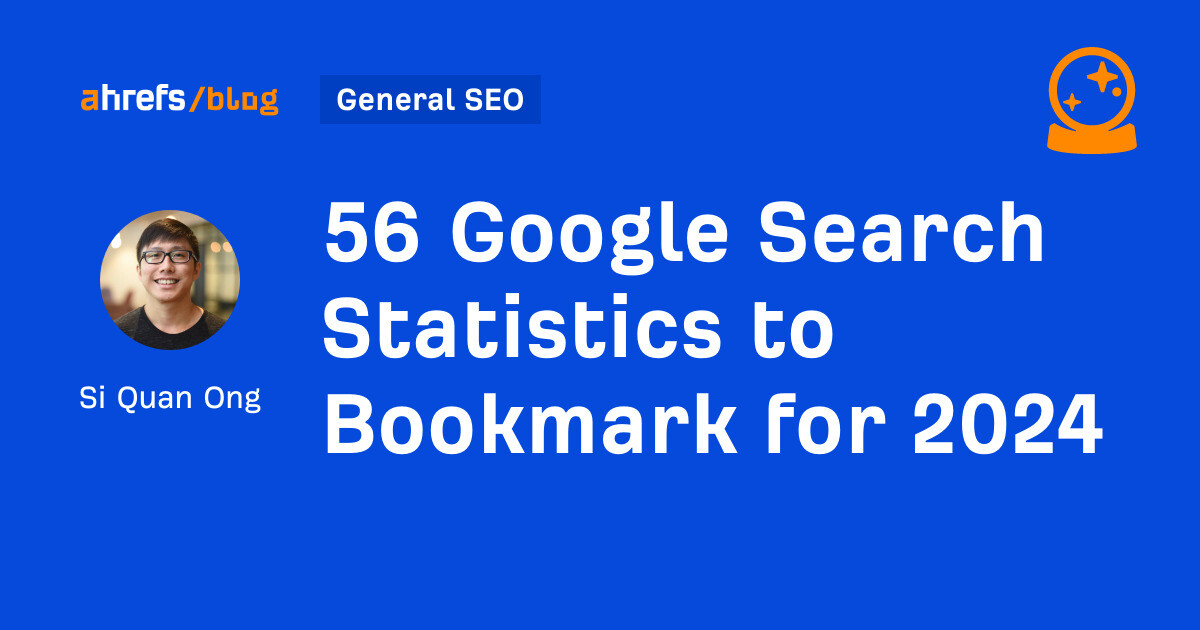
If you’re curious about the state of Google search in 2024, look no further.
Each year we pick, vet, and categorize a list of up-to-date statistics to give you insights from trusted sources on Google search trends.
Check out more resources on how Google works:
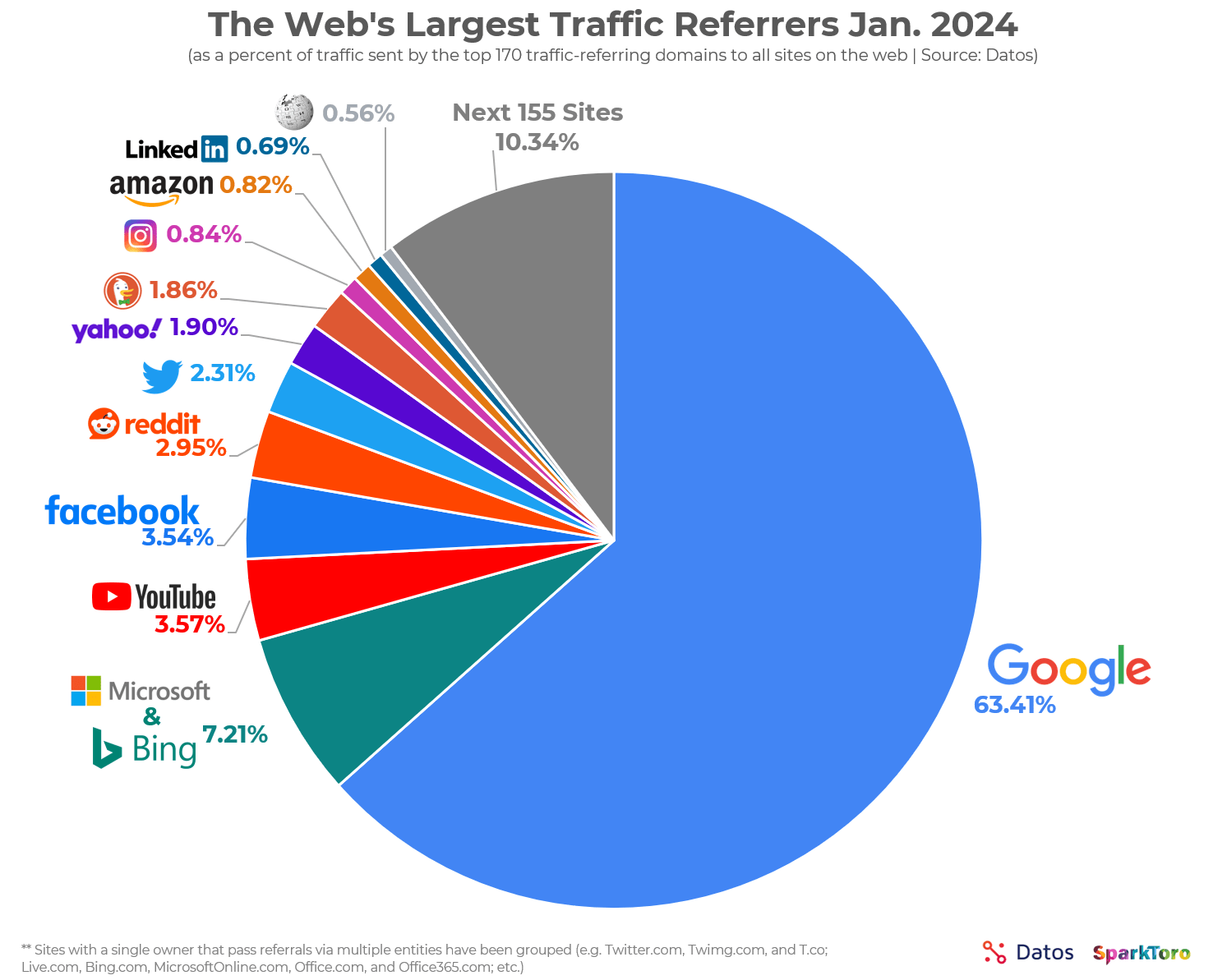

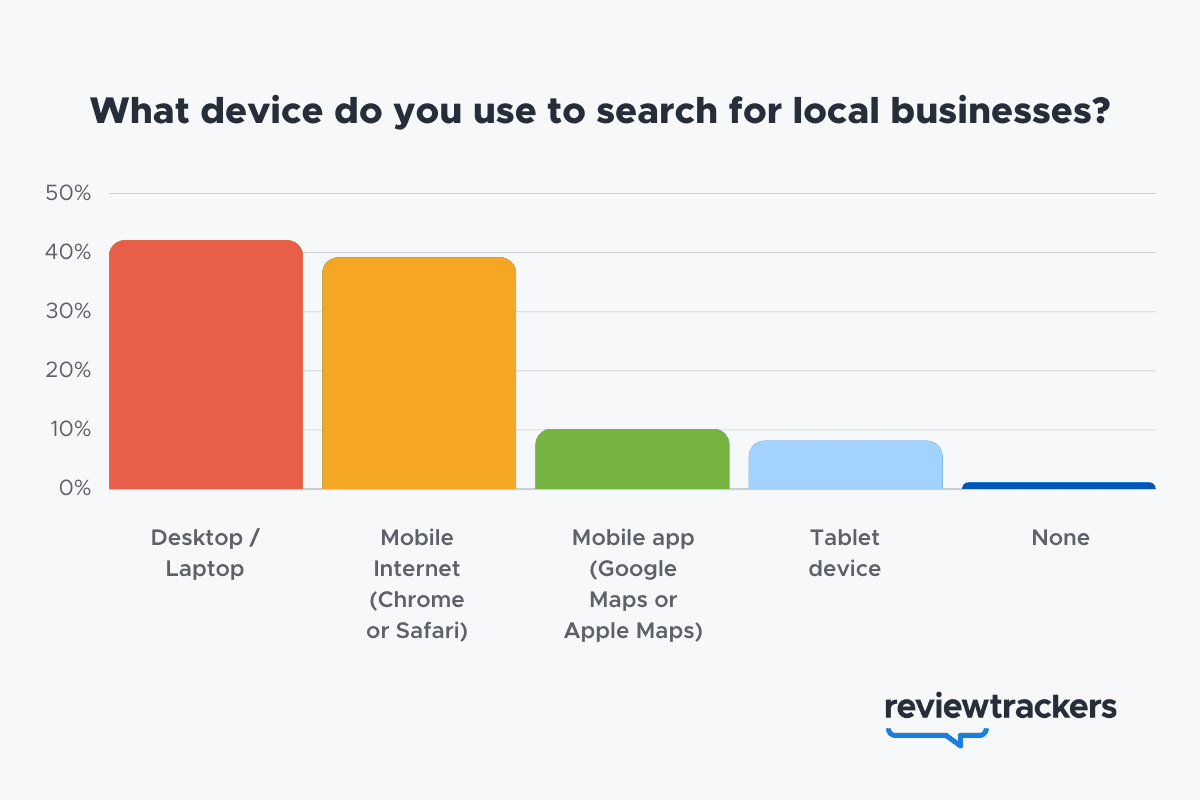

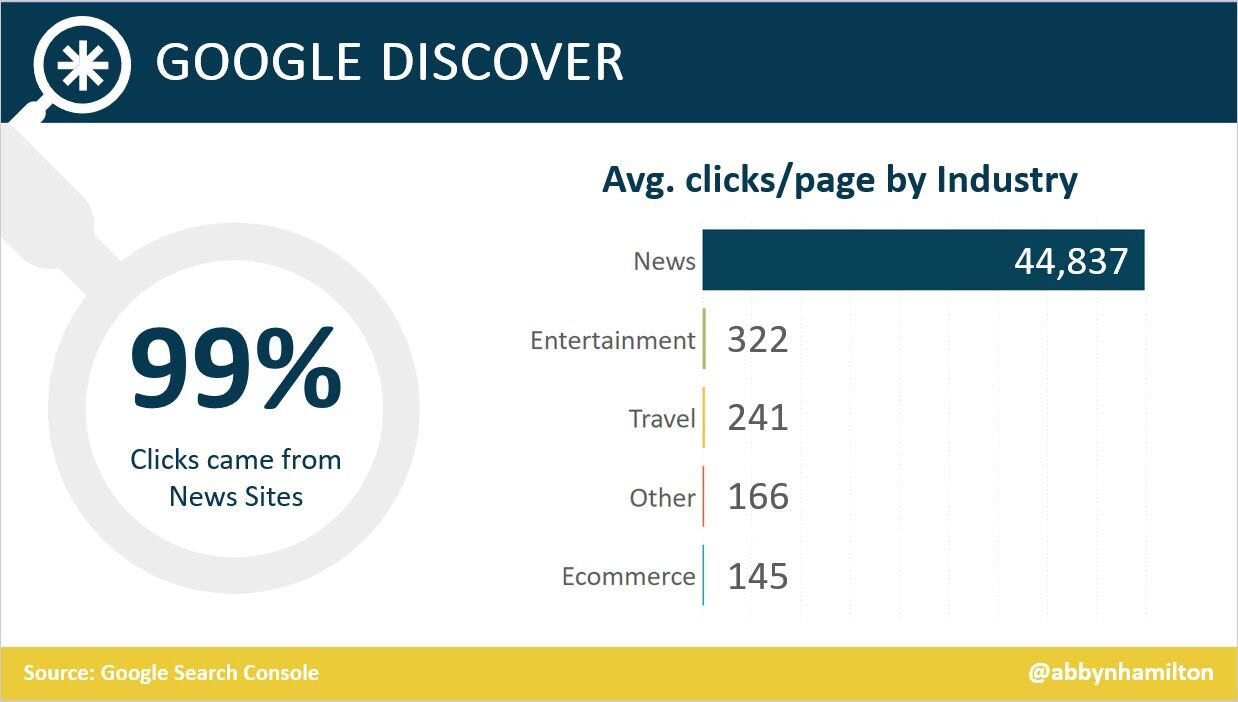



Learn more
SEO
How To Use ChatGPT For Keyword Research

Anyone not using ChatGPT for keyword research is missing a trick.
You can save time and understand an entire topic in seconds instead of hours.
In this article, I outline my most effective ChatGPT prompts for keyword research and teach you how I put them together so that you, too, can take, edit, and enhance them even further.
But before we jump into the prompts, I want to emphasize that you shouldn’t replace keyword research tools or disregard traditional keyword research methods.
ChatGPT can make mistakes. It can even create new keywords if you give it the right prompt. For example, I asked it to provide me with a unique keyword for the topic “SEO” that had never been searched before.
“Interstellar Internet SEO: Optimizing content for the theoretical concept of an interstellar internet, considering the challenges of space-time and interplanetary communication delays.”
Although I want to jump into my LinkedIn profile and update my title to “Interstellar Internet SEO Consultant,” unfortunately, no one has searched that (and they probably never will)!
You must not blindly rely on the data you get back from ChatGPT.
What you can rely on ChatGPT for is the topic ideation stage of keyword research and inspiration.
ChatGPT is a large language model trained with massive amounts of data to accurately predict what word will come next in a sentence. However, it does not know how to do keyword research yet.
Instead, think of ChatGPT as having an expert on any topic armed with the information if you ask it the right question.
In this guide, that is exactly what I aim to teach you how to do – the most essential prompts you need to know when performing topical keyword research.
Best ChatGPT Keyword Research Prompts
The following ChatGPT keyword research prompts can be used on any niche, even a topic to which you are brand new.
For this demonstration, let’s use the topic of “SEO” to demonstrate these prompts.
Generating Keyword Ideas Based On A Topic
What Are The {X} Most Popular Sub-topics Related To {Topic}?
The first prompt is to give you an idea of the niche.
As shown above, ChatGPT did a great job understanding and breaking down SEO into three pillars: on-page, off-page & technical.
The key to the following prompt is to take one of the topics ChatGPT has given and query the sub-topics.
What Are The {X} Most Popular Sub-topics Related To {Sub-topic}?
For this example, let’s query, “What are the most popular sub-topics related to keyword research?”
Having done keyword research for over 10 years, I would expect it to output information related to keyword research metrics, the types of keywords, and intent.
Let’s see.
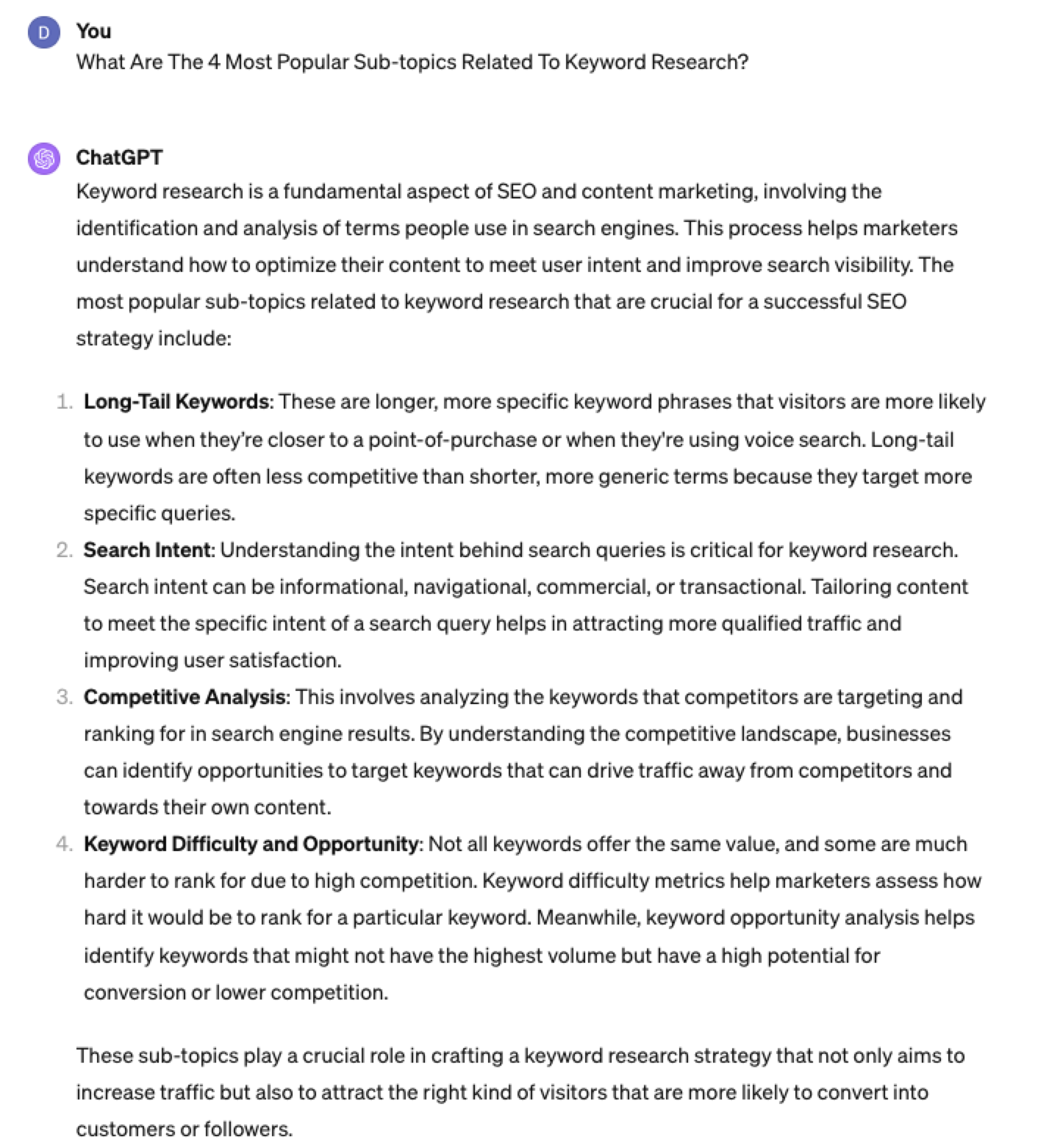 Screenshot from ChatGPT 4, April 2024
Screenshot from ChatGPT 4, April 2024Again, right on the money.
To get the keywords you want without having ChatGPT describe each answer, use the prompt “list without description.”
Here is an example of that.
List Without Description The Top {X} Most Popular Keywords For The Topic Of {X}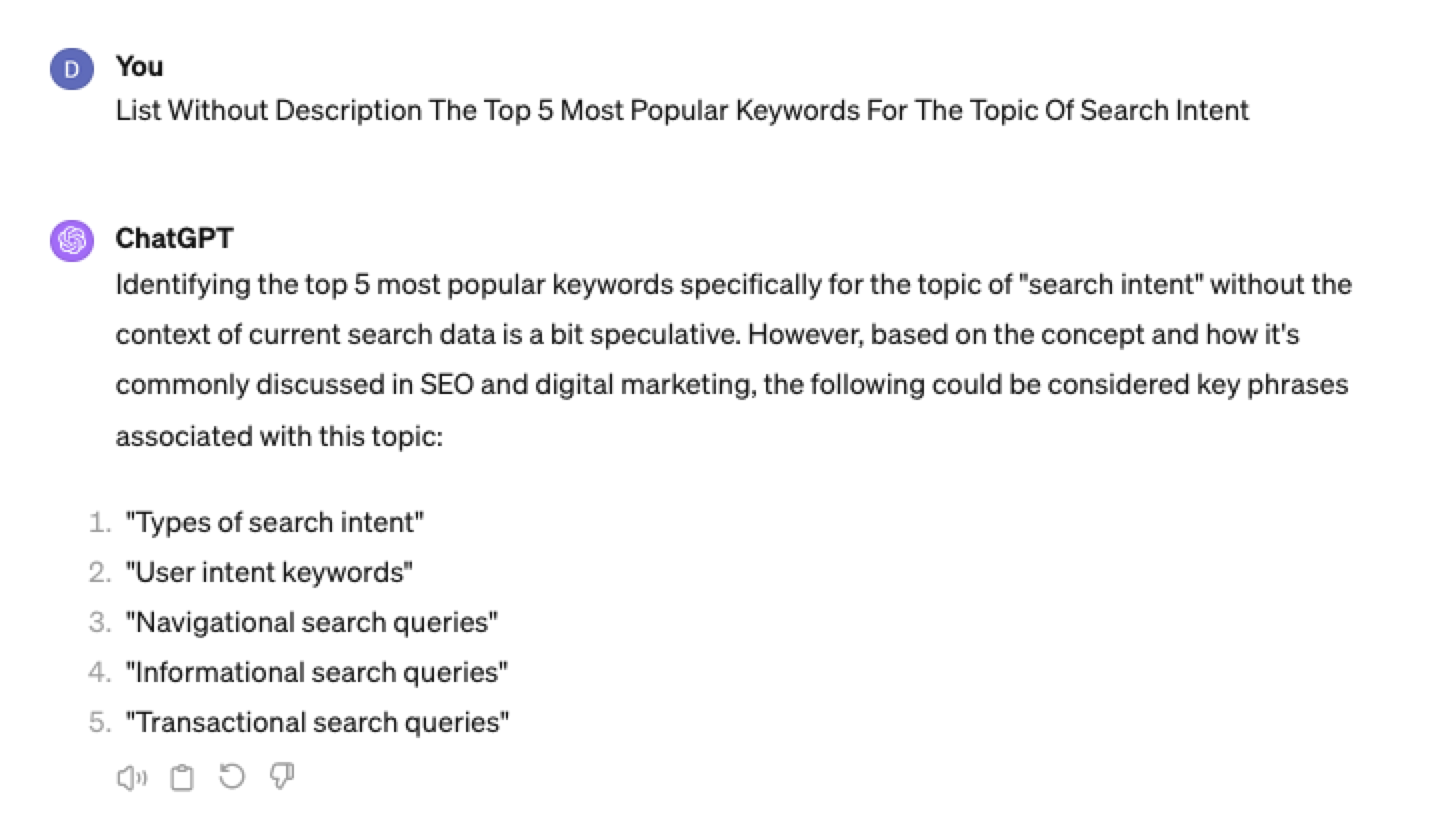
You can even branch these keywords out further into their long-tail.
Example prompt:
List Without Description The Top {X} Most Popular Long-tail Keywords For The Topic “{X}”
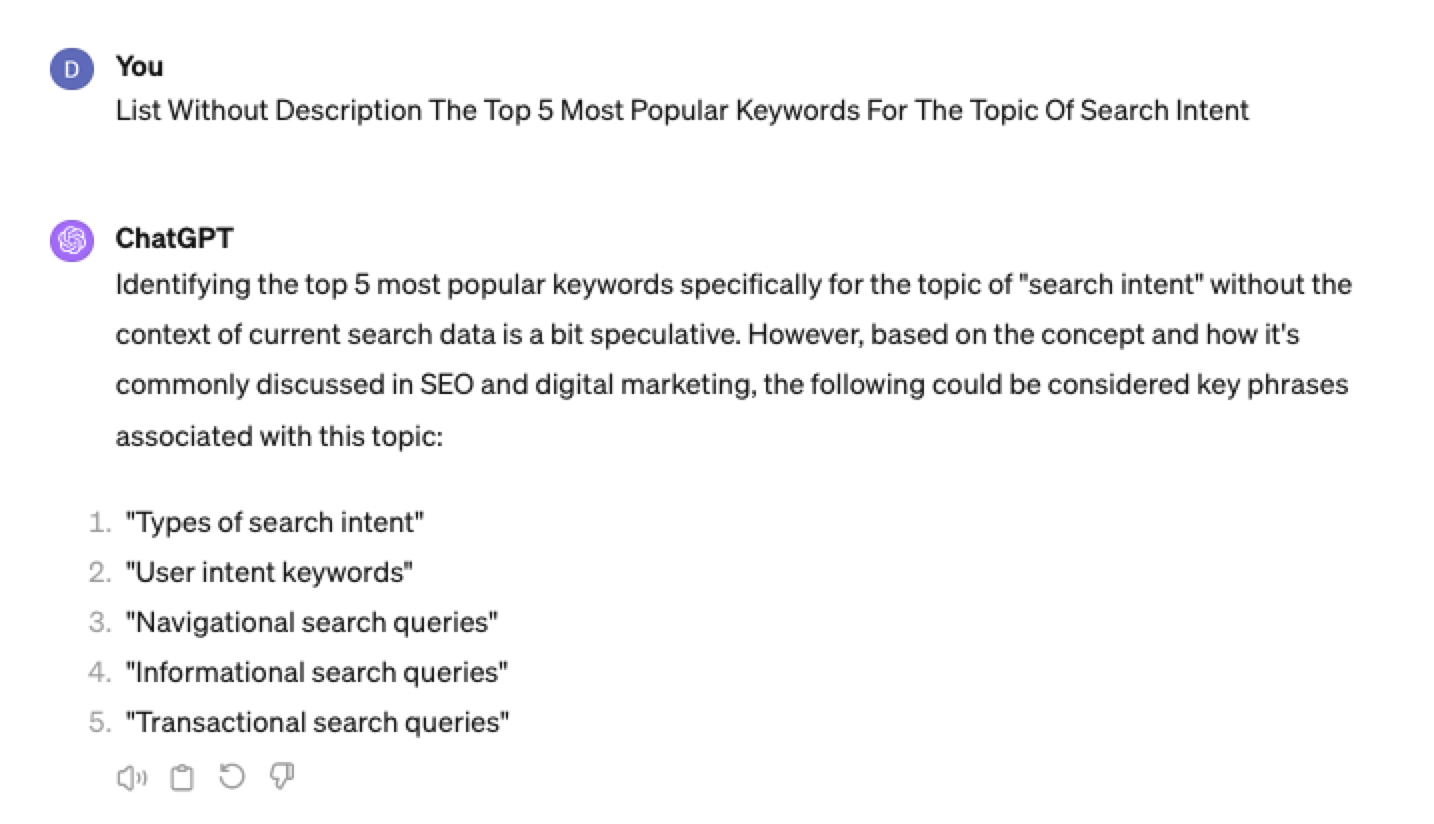 Screenshot ChatGPT 4,April 2024
Screenshot ChatGPT 4,April 2024List Without Description The Top Semantically Related Keywords And Entities For The Topic {X}
You can even ask ChatGPT what any topic’s semantically related keywords and entities are!
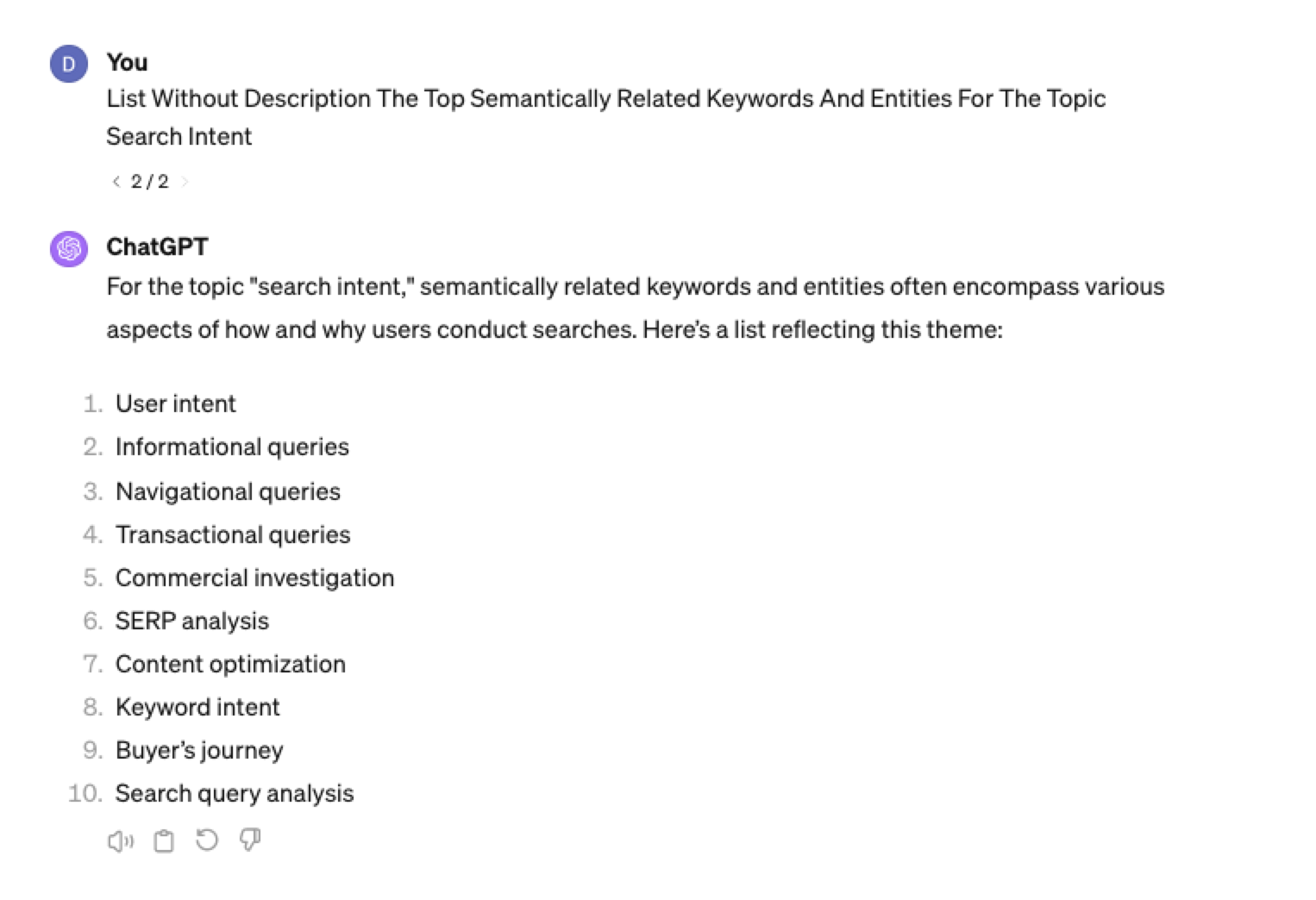 Screenshot ChatGPT 4, April 2024
Screenshot ChatGPT 4, April 2024Tip: The Onion Method Of Prompting ChatGPT
When you are happy with a series of prompts, add them all to one prompt. For example, so far in this article, we have asked ChatGPT the following:
- What are the four most popular sub-topics related to SEO?
- What are the four most popular sub-topics related to keyword research
- List without description the top five most popular keywords for “keyword intent”?
- List without description the top five most popular long-tail keywords for the topic “keyword intent types”?
- List without description the top semantically related keywords and entities for the topic “types of keyword intent in SEO.”
Combine all five into one prompt by telling ChatGPT to perform a series of steps. Example:
“Perform the following steps in a consecutive order Step 1, Step 2, Step 3, Step 4, and Step 5”
Example:
“Perform the following steps in a consecutive order Step 1, Step 2, Step 3, Step 4 and Step 5. Step 1 – Generate an answer for the 3 most popular sub-topics related to {Topic}?. Step 2 – Generate 3 of the most popular sub-topics related to each answer. Step 3 – Take those answers and list without description their top 3 most popular keywords. Step 4 – For the answers given of their most popular keywords, provide 3 long-tail keywords. Step 5 – for each long-tail keyword offered in the response, a list without descriptions 3 of their top semantically related keywords and entities.”
Generating Keyword Ideas Based On A Question
Taking the steps approach from above, we can get ChatGPT to help streamline getting keyword ideas based on a question. For example, let’s ask, “What is SEO?”
“Perform the following steps in a consecutive order Step 1, Step 2, Step 3, and Step 4. Step 1 Generate 10 questions about “{Question}”?. Step 2 – Generate 5 more questions about “{Question}” that do not repeat the above. Step 3 – Generate 5 more questions about “{Question}” that do not repeat the above. Step 4 – Based on the above Steps 1,2,3 suggest a final list of questions avoiding duplicates or semantically similar questions.”
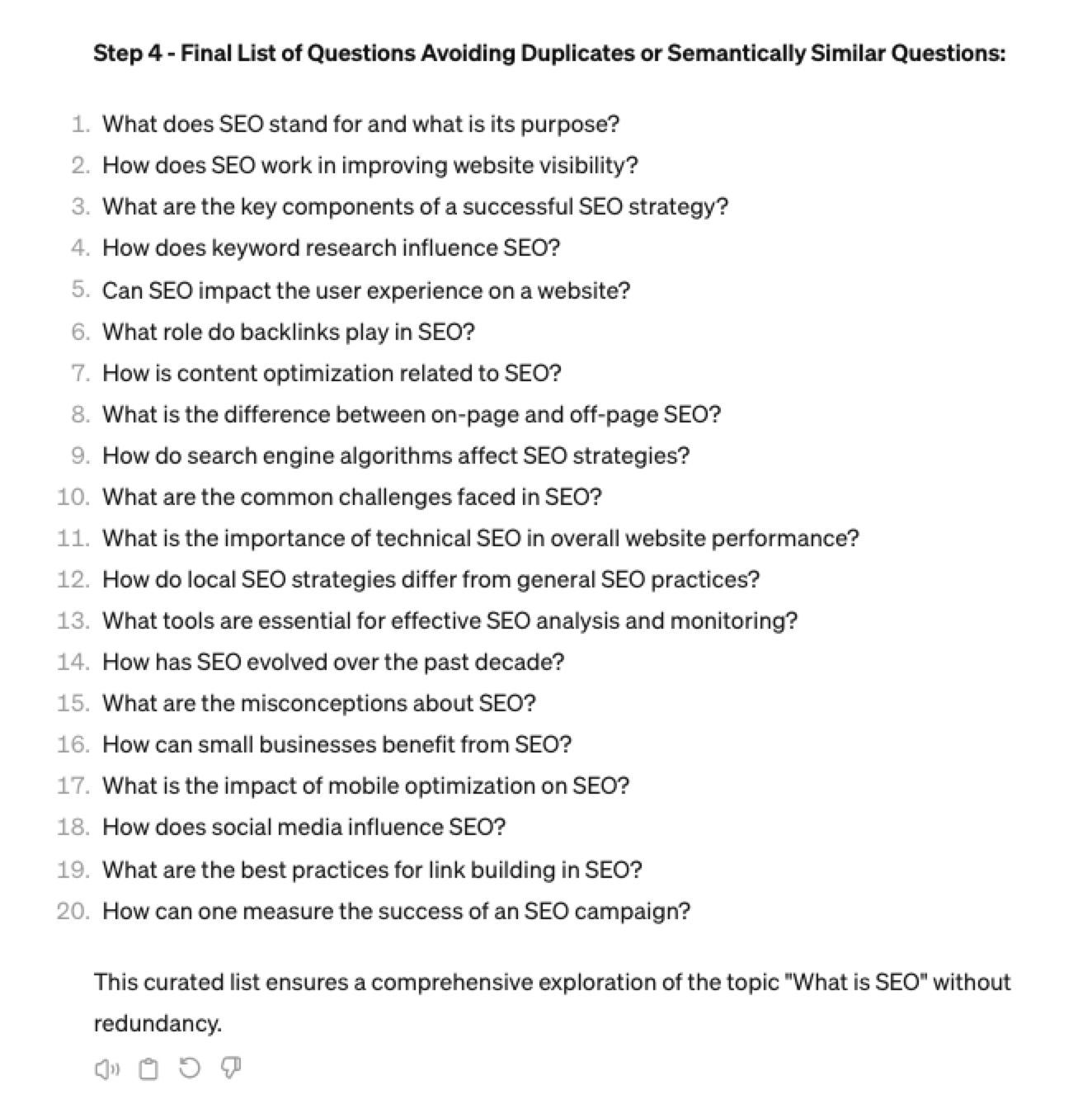 Screenshot ChatGPT 4, April 2024
Screenshot ChatGPT 4, April 2024Generating Keyword Ideas Using ChatGPT Based On The Alphabet Soup Method
One of my favorite methods, manually, without even using a keyword research tool, is to generate keyword research ideas from Google autocomplete, going from A to Z.
-
 Screenshot from Google autocomplete, April 2024
Screenshot from Google autocomplete, April 2024
You can also do this using ChatGPT.
Example prompt:
“give me popular keywords that includes the keyword “SEO”, and the next letter of the word starts with a”
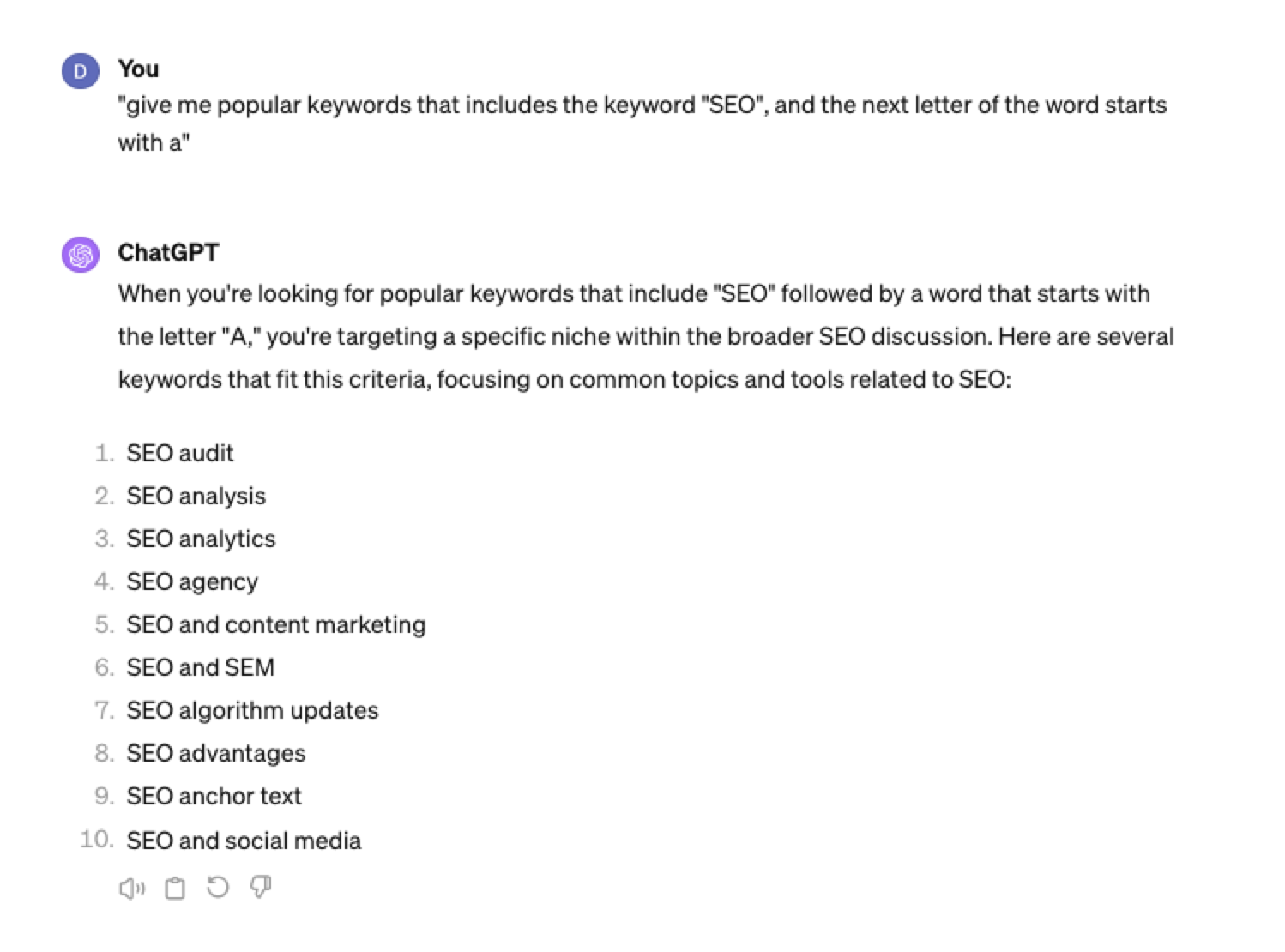 Screenshot from ChatGPT 4, April 2024
Screenshot from ChatGPT 4, April 2024Tip: Using the onion prompting method above, we can combine all this in one prompt.
“Give me five popular keywords that include “SEO” in the word, and the following letter starts with a. Once the answer has been done, move on to giving five more popular keywords that include “SEO” for each letter of the alphabet b to z.”
Generating Keyword Ideas Based On User Personas
When it comes to keyword research, understanding user personas is essential for understanding your target audience and keeping your keyword research focused and targeted. ChatGPT may help you get an initial understanding of customer personas.
Example prompt:
“For the topic of “{Topic}” list 10 keywords each for the different types of user personas”
 Screenshot from ChatGPT 4, April 2024
Screenshot from ChatGPT 4, April 2024You could even go a step further and ask for questions based on those topics that those specific user personas may be searching for:
 Screenshot ChatGPT 4, April 2024
Screenshot ChatGPT 4, April 2024As well as get the keywords to target based on those questions:
“For each question listed above for each persona, list the keywords, as well as the long-tail keywords to target, and put them in a table”
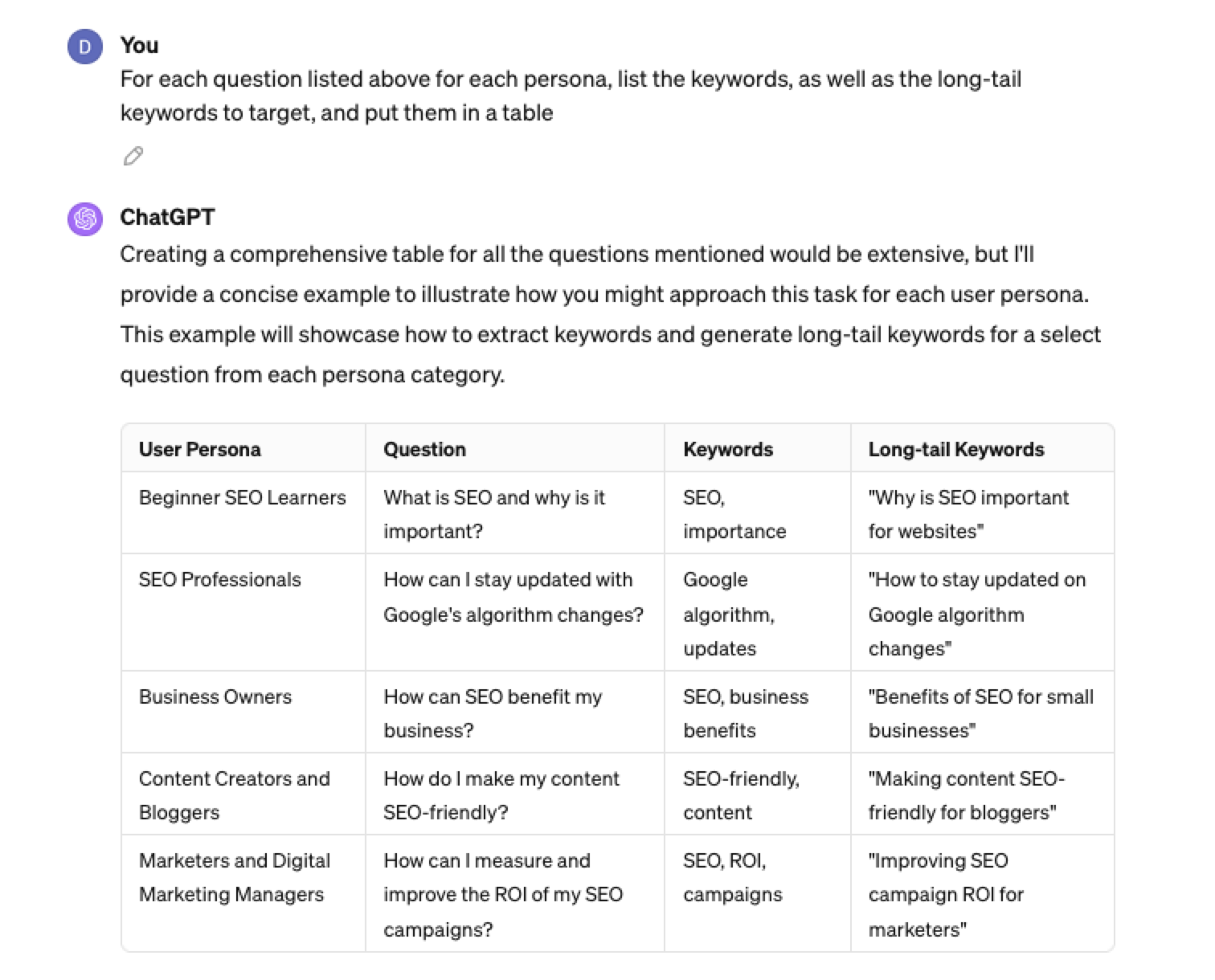 Screenshot from ChatGPT 4, April 2024
Screenshot from ChatGPT 4, April 2024Generating Keyword Ideas Using ChatGPT Based On Searcher Intent And User Personas
Understanding the keywords your target persona may be searching is the first step to effective keyword research. The next step is to understand the search intent behind those keywords and which content format may work best.
For example, a business owner who is new to SEO or has just heard about it may be searching for “what is SEO.”
However, if they are further down the funnel and in the navigational stage, they may search for “top SEO firms.”
You can query ChatGPT to inspire you here based on any topic and your target user persona.
SEO Example:
“For the topic of “{Topic}” list 10 keywords each for the different types of searcher intent that a {Target Persona} would be searching for”
ChatGPT For Keyword Research Admin
Here is how you can best use ChatGPT for keyword research admin tasks.
Using ChatGPT As A Keyword Categorization Tool
One of the use cases for using ChatGPT is for keyword categorization.
In the past, I would have had to devise spreadsheet formulas to categorize keywords or even spend hours filtering and manually categorizing keywords.
ChatGPT can be a great companion for running a short version of this for you.
Let’s say you have done keyword research in a keyword research tool, have a list of keywords, and want to categorize them.
You could use the following prompt:
“Filter the below list of keywords into categories, target persona, searcher intent, search volume and add information to a six-column table: List of keywords – [LIST OF KEYWORDS], Keyword Search Volume [SEARCH VOLUMES] and Keyword Difficulties [KEYWORD DIFFICUTIES].”
-
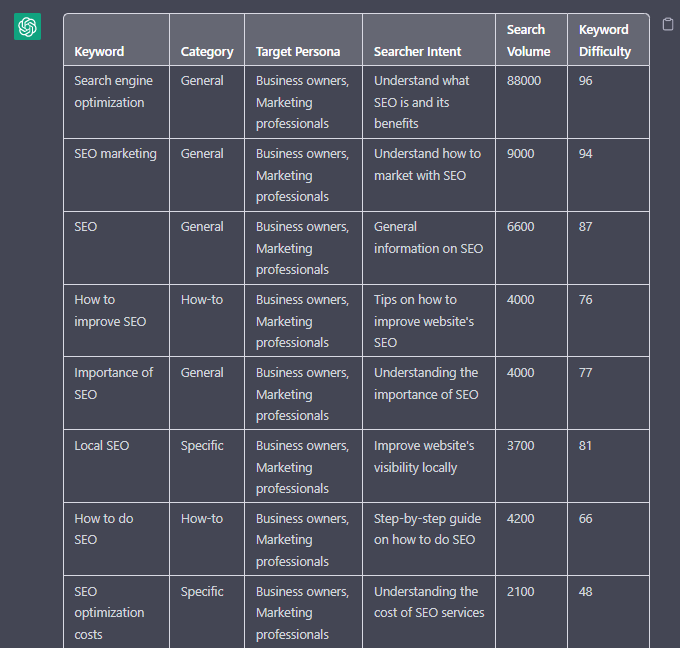 Screenshot from ChatGPT, April 2024
Screenshot from ChatGPT, April 2024
Tip: Add keyword metrics from the keyword research tools, as using the search volumes that a ChatGPT prompt may give you will be wildly inaccurate at best.
Using ChatGPT For Keyword Clustering
Another of ChatGPT’s use cases for keyword research is to help you cluster. Many keywords have the same intent, and by grouping related keywords, you may find that one piece of content can often target multiple keywords at once.
However, be careful not to rely only on LLM data for clustering. What ChatGPT may cluster as a similar keyword, the SERP or the user may not agree with. But it is a good starting point.
The big downside of using ChatGPT for keyword clustering is actually the amount of keyword data you can cluster based on the memory limits.
So, you may find a keyword clustering tool or script that is better for large keyword clustering tasks. But for small amounts of keywords, ChatGPT is actually quite good.
A great use small keyword clustering use case using ChatGPT is for grouping People Also Ask (PAA) questions.
Use the following prompt to group keywords based on their semantic relationships. For example:
“Organize the following keywords into groups based on their semantic relationships, and give a short name to each group: [LIST OF PAA], create a two-column table where each keyword sits on its own row.
-
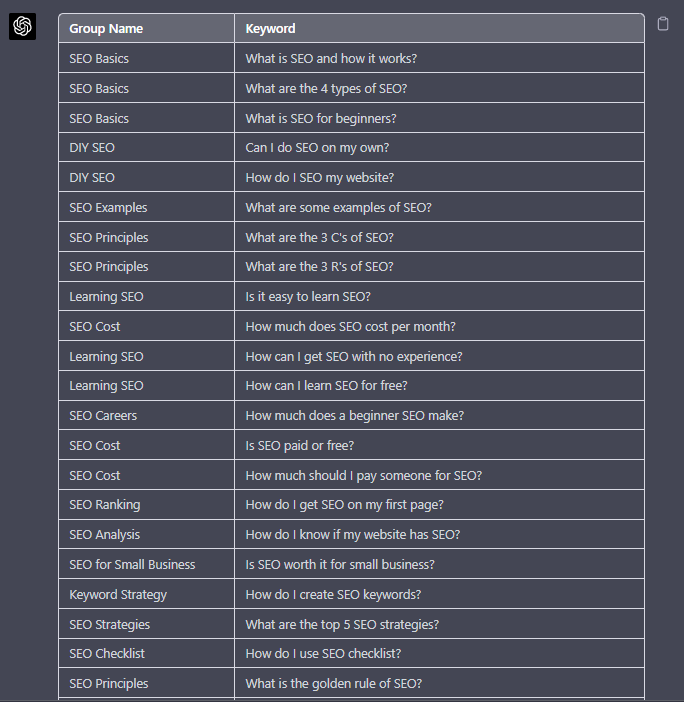 Screenshot from ChatGPT, April 2024
Screenshot from ChatGPT, April 2024
Using Chat GPT For Keyword Expansion By Patterns
One of my favorite methods of doing keyword research is pattern spotting.
Most seed keywords have a variable that can expand your target keywords.
Here are a few examples of patterns:
1. Question Patterns
(who, what, where, why, how, are, can, do, does, will)
“Generate [X] keywords for the topic “[Topic]” that contain any or all of the following “who, what, where, why, how, are, can, do, does, will”
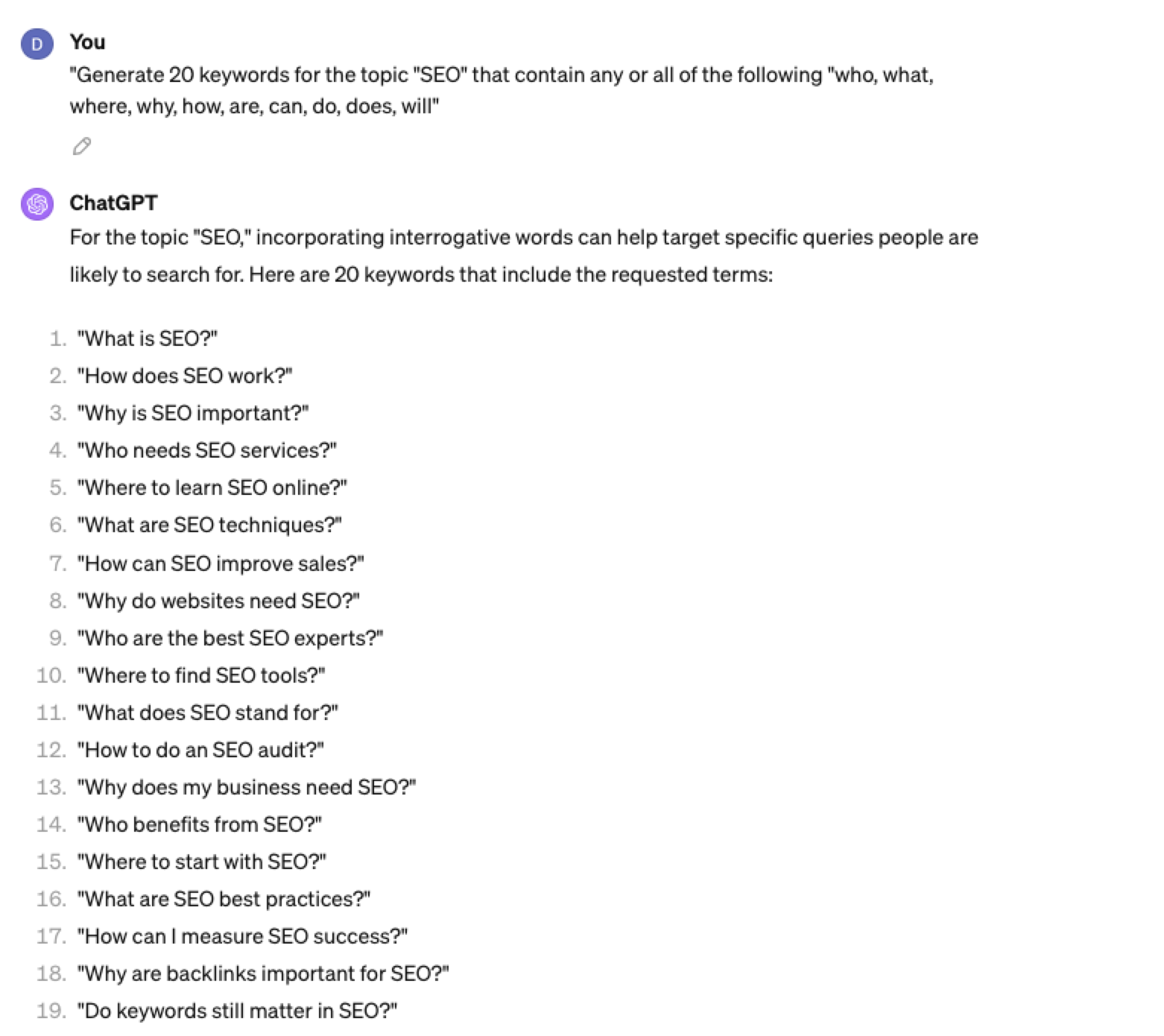 Screenshot ChatGPT 4, April 2024
Screenshot ChatGPT 4, April 20242. Comparison Patterns
Example:
“Generate 50 keywords for the topic “{Topic}” that contain any or all of the following “for, vs, alternative, best, top, review”
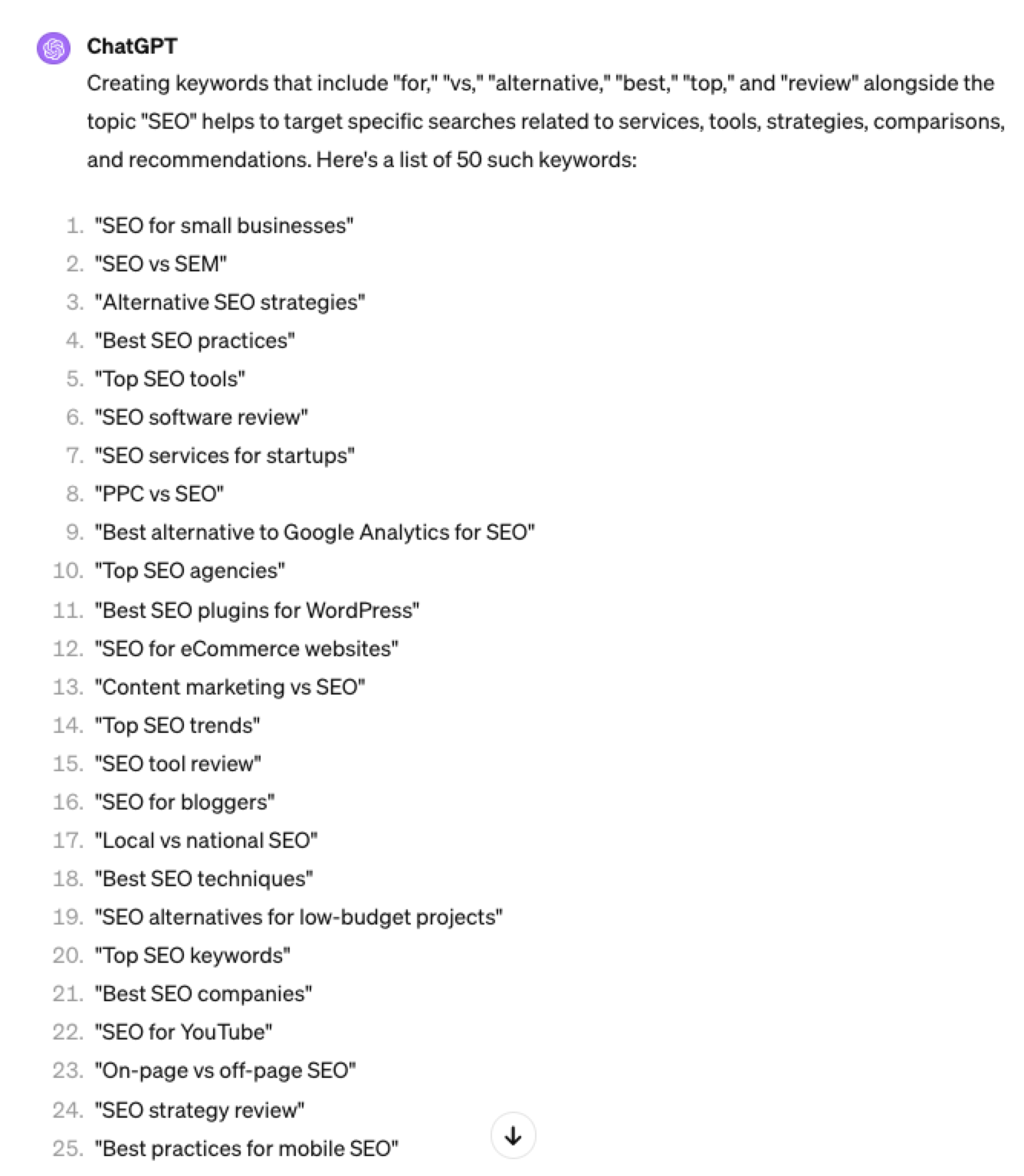 Screenshot ChatGPT 4, April 2024
Screenshot ChatGPT 4, April 20243. Brand Patterns
Another one of my favorite modifiers is a keyword by brand.
We are probably all familiar with the most popular SEO brands; however, if you aren’t, you could ask your AI friend to do the heavy lifting.
Example prompt:
“For the top {Topic} brands what are the top “vs” keywords”
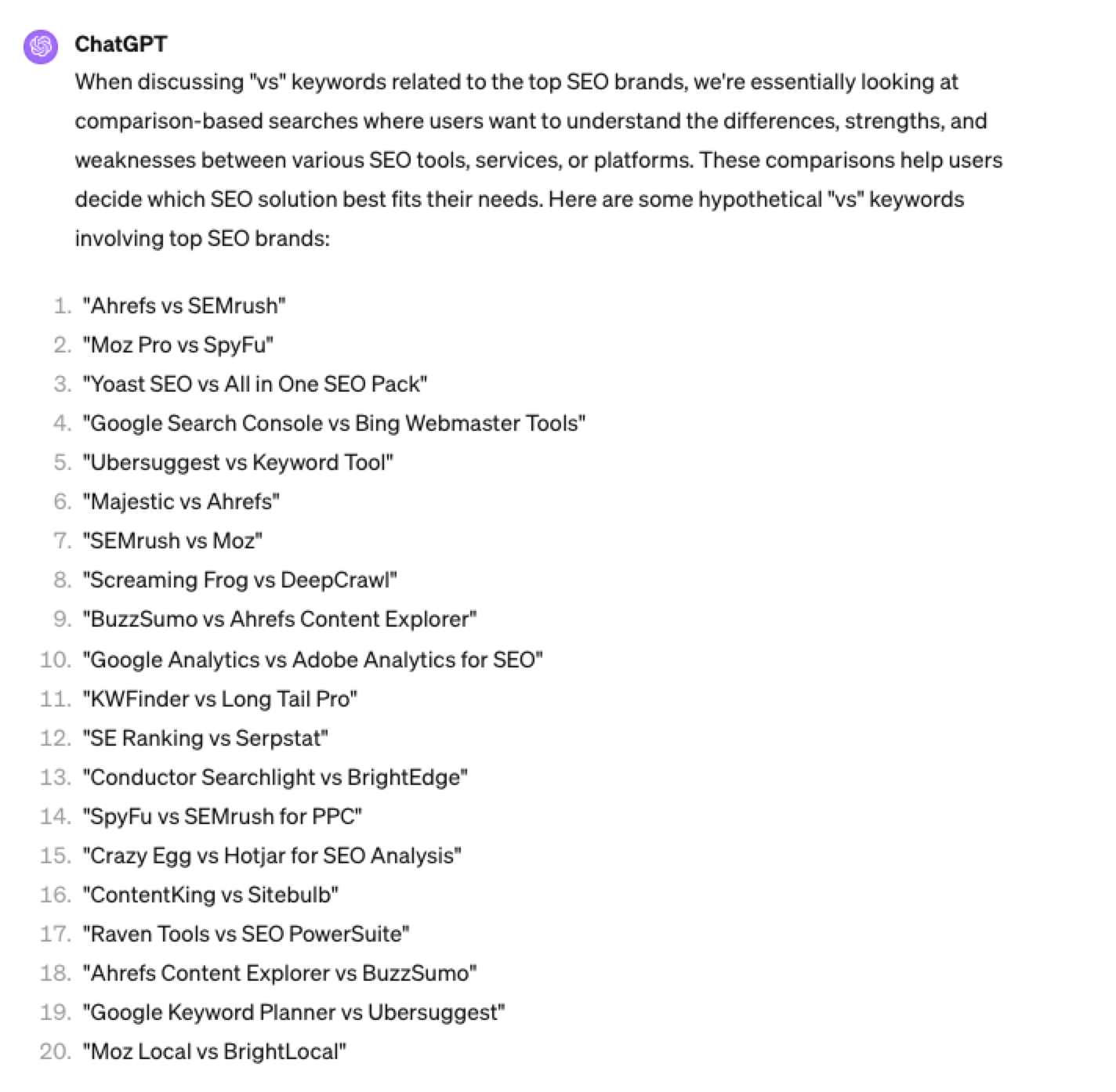 Screenshot ChatGPT 4, April 2024
Screenshot ChatGPT 4, April 20244. Search Intent Patterns
One of the most common search intent patterns is “best.”
When someone is searching for a “best {topic}” keyword, they are generally searching for a comprehensive list or guide that highlights the top options, products, or services within that specific topic, along with their features, benefits, and potential drawbacks, to make an informed decision.
Example:
“For the topic of “[Topic]” what are the 20 top keywords that include “best”
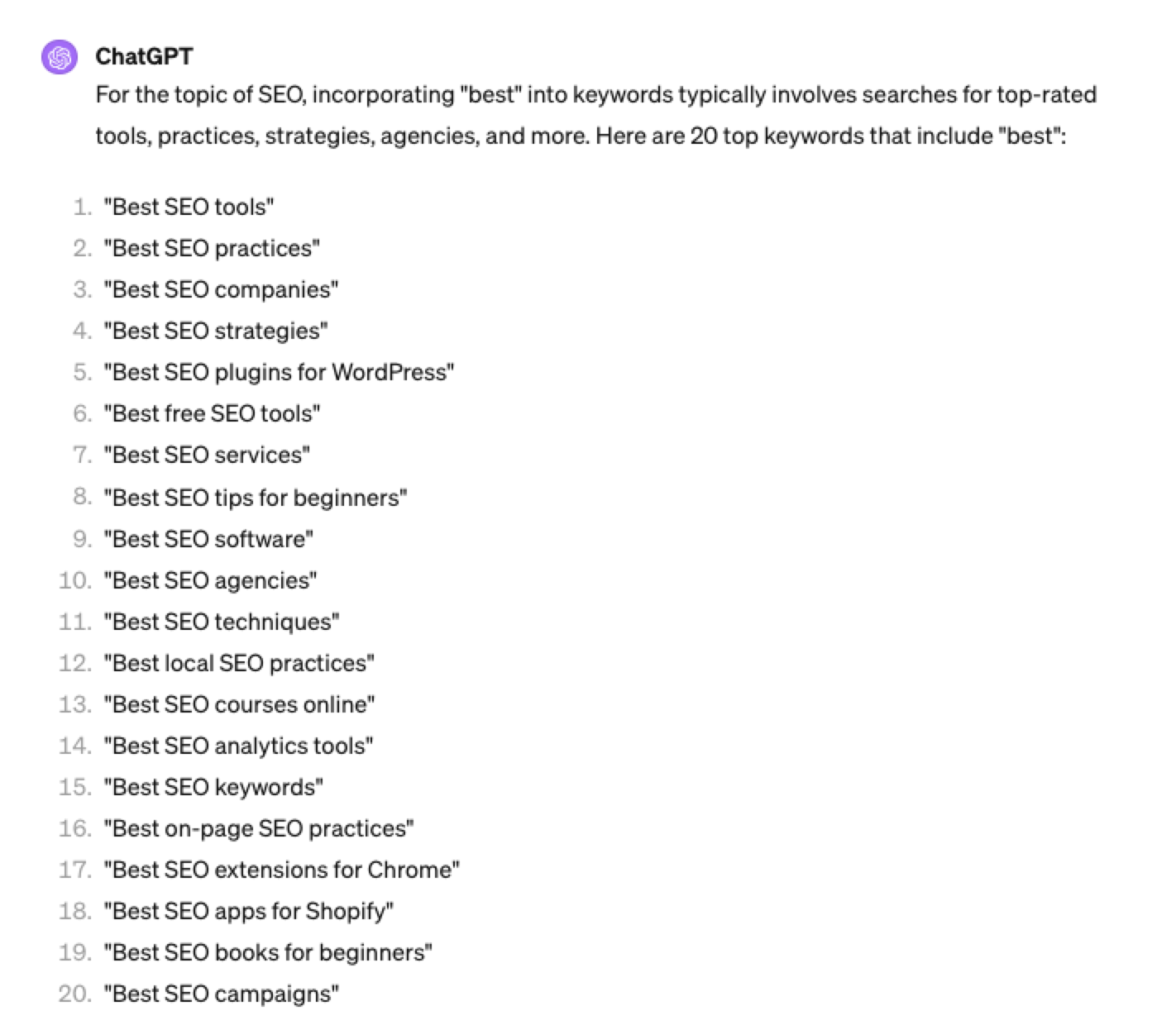 Screenshot ChatGPT 4, April 2024
Screenshot ChatGPT 4, April 2024Again, this guide to keyword research using ChatGPT has emphasized the ease of generating keyword research ideas by utilizing ChatGPT throughout the process.
Keyword Research Using ChatGPT Vs. Keyword Research Tools
Free Vs. Paid Keyword Research Tools
Like keyword research tools, ChatGPT has free and paid options.
However, one of the most significant drawbacks of using ChatGPT for keyword research alone is the absence of SEO metrics to help you make smarter decisions.
To improve accuracy, you could take the results it gives you and verify them with your classic keyword research tool – or vice versa, as shown above, uploading accurate data into the tool and then prompting.
However, you must consider how long it takes to type and fine-tune your prompt to get your desired data versus using the filters within popular keyword research tools.
For example, if we use a popular keyword research tool using filters, you could have all of the “best” queries with all of their SEO metrics:
-
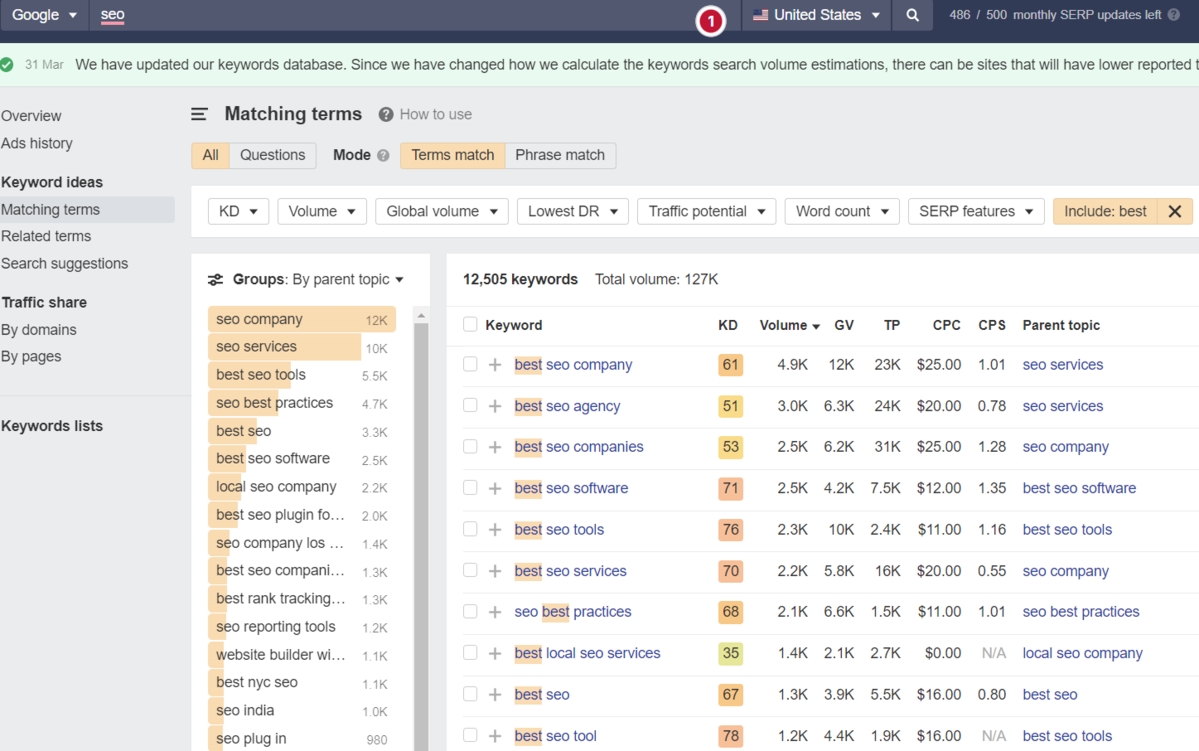 Screenshot from Ahrefs Keyword Explorer, March 2024
Screenshot from Ahrefs Keyword Explorer, March 2024
And unlike ChatGPT, generally, there is no token limit; you can extract several hundred, if not thousands, of keywords at a time.
As I have mentioned multiple times throughout this piece, you cannot blindly trust the data or SEO metrics it may attempt to provide you with.
The key is to validate the keyword research with a keyword research tool.
ChatGPT For International SEO Keyword Research
ChatGPT can be a terrific multilingual keyword research assistant.
For example, if you wanted to research keywords in a foreign language such as French. You could ask ChatGPT to translate your English keywords;
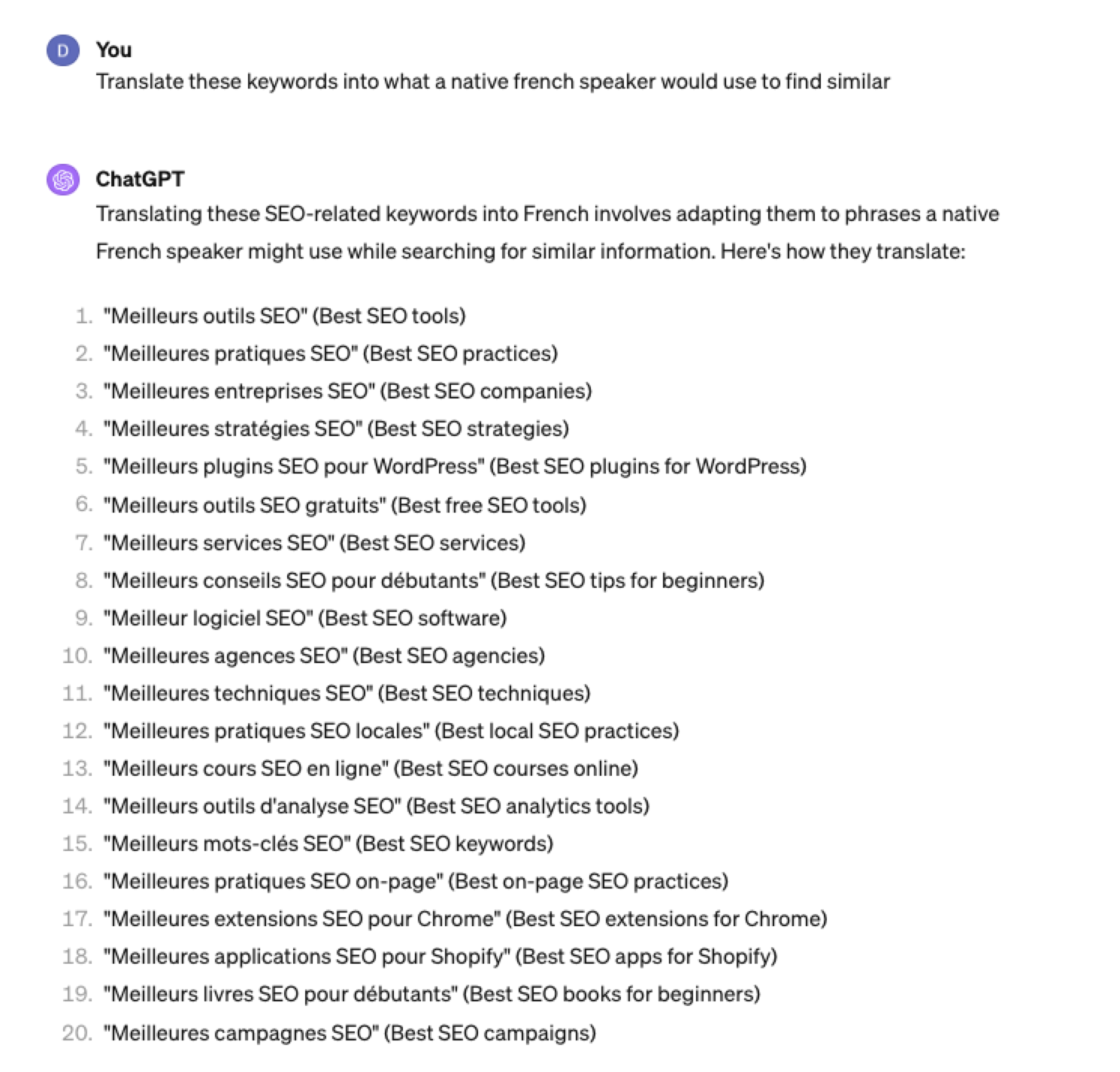 Screenshot ChatGPT 4, Apil 2024
Screenshot ChatGPT 4, Apil 2024- The key is to take the data above and paste it into a popular keyword research tool to verify.
- As you can see below, many of the keyword translations for the English keywords do not have any search volume for direct translations in French.
 Screenshot from Ahrefs Keyword Explorer, April 2024
Screenshot from Ahrefs Keyword Explorer, April 2024But don’t worry, there is a workaround: If you have access to a competitor keyword research tool, you can see what webpage is ranking for that query – and then identify the top keyword for that page based on the ChatGPT translated keywords that do have search volume.
-
-
 Screenshot from Ahrefs Keyword Explorer, April 2024
Screenshot from Ahrefs Keyword Explorer, April 2024
Or, if you don’t have access to a paid keyword research tool, you could always take the top-performing result, extract the page copy, and then ask ChatGPT what the primary keyword for the page is.
Key Takeaway
-
ChatGPT can be an expert on any topic and an invaluable keyword research tool. However, it is another tool to add to your toolbox when doing keyword research; it does not replace traditional keyword research tools.
As shown throughout this tutorial, from making up keywords at the beginning to inaccuracies around data and translations, ChatGPT can make mistakes when used for keyword research.
You cannot blindly trust the data you get back from ChatGPT.
However, it can offer a shortcut to understanding any topic for which you need to do keyword research and, as a result, save you countless hours.
But the key is how you prompt.
The prompts I shared with you above will help you understand a topic in minutes instead of hours and allow you to better seed keywords using keyword research tools.
It can even replace mundane keyword clustering tasks that you used to do with formulas in spreadsheets or generate ideas based on keywords you give it.
Paired with traditional keyword research tools, ChatGPT for keyword research can be a powerful tool in your arsenal.
More resources:
Featured Image: Tatiana Shepeleva/Shutterstock
SEO
OpenAI Expected to Integrate Real-Time Data In ChatGPT

Sam Altman, CEO of OpenAI, dispelled rumors that a new search engine would be announced on Monday, May 13. Recent deals have raised the expectation that OpenAI will announce the integration of real-time content from English, Spanish, and French publications into ChatGPT, complete with links to the original sources.
OpenAI Search Is Not Happening
Many competing search engines have tried and failed to challenge Google as the leading search engine. A new wave of hybrid generative AI search engines is currently trying to knock Google from the top spot with arguably very little success.
Sam Altman is on record saying that creating a search engine to compete against Google is not a viable approach. He suggested that technological disruption was the way to replace Google by changing the search paradigm altogether. The speculation that Altman is going to announce a me-too search engine on Monday never made sense given his recent history of dismissing the concept as a non-starter.
So perhaps it’s not a surprise that he recently ended the speculation by explicitly saying that he will not be announcing a search engine on Monday.
He tweeted:
“not gpt-5, not a search engine, but we’ve been hard at work on some new stuff we think people will love! feels like magic to me.”
“New Stuff” May Be Iterative Improvement
It’s quite likely that what’s going to be announced is iterative which means it improves ChatGPT but not replaces it. This fits into how Altman recently expressed his approach with ChatGPT.
He remarked:
“And it does kind of suck to ship a product that you’re embarrassed about, but it’s much better than the alternative. And in this case in particular, where I think we really owe it to society to deploy iteratively.
There could totally be things in the future that would change where we think iterative deployment isn’t such a good strategy, but it does feel like the current best approach that we have and I think we’ve gained a lot from from doing this and… hopefully the larger world has gained something too.”
Improving ChatGPT iteratively is Sam Altman’s preference and recent clues point to what those changes may be.
Recent Deals Contain Clues
OpenAI has been making deals with news media and User Generated Content publishers since December 2023. Mainstream media has reported these deals as being about licensing content for training large language models. But they overlooked a a key detail that we reported on last month which is that these deals give OpenAI access to real-time information that they stated will be used to give attribution to that real-time data in the form of links.
That means that ChatGPT users will gain the ability to access real-time news and to use that information creatively within ChatGPT.
Dotdash Meredith Deal
Dotdash Meredith (DDM) is the publisher of big brand publications such as Better Homes & Gardens, FOOD & WINE, InStyle, Investopedia, and People magazine. The deal that was announced goes way beyond using the content as training data. The deal is explicitly about surfacing the Dotdash Meredith content itself in ChatGPT.
The announcement stated:
“As part of the agreement, OpenAI will display content and links attributed to DDM in relevant ChatGPT responses. …This deal is a testament to the great work OpenAI is doing on both fronts to partner with creators and publishers and ensure a healthy Internet for the future.
Over 200 million Americans each month trust our content to help them make decisions, solve problems, find inspiration, and live fuller lives. This partnership delivers the best, most relevant content right to the heart of ChatGPT.”
A statement from OpenAI gives credibility to the speculation that OpenAI intends to directly show licensed third-party content as part of ChatGPT answers.
OpenAI explained:
“We’re thrilled to partner with Dotdash Meredith to bring its trusted brands to ChatGPT and to explore new approaches in advancing the publishing and marketing industries.”
Something that DDM also gets out of this deal is that OpenAI will enhance DDM’s in-house ad targeting in order show more tightly focused contextual advertising.
Le Monde And Prisa Media Deals
In March 2024 OpenAI announced a deal with two global media companies, Le Monde and Prisa Media. Le Monde is a French news publication and Prisa Media is a Spanish language multimedia company. The interesting aspects of these two deals is that it gives OpenAI access to real-time data in French and Spanish.
Prisa Media is a global Spanish language media company based in Madrid, Spain that is comprised of magazines, newspapers, podcasts, radio stations, and television networks. It’s reach extends from Spain to America. American media companies include publications in the United States, Argentina, Bolivia, Chile, Colombia, Costa Rica, Ecuador, Mexico, and Panama. That is a massive amount of real-time information in addition to a massive audience of millions.
OpenAI explicitly announced that the purpose of this deal was to bring this content directly to ChatGPT users.
The announcement explained:
“We are continually making improvements to ChatGPT and are supporting the essential role of the news industry in delivering real-time, authoritative information to users. …Our partnerships will enable ChatGPT users to engage with Le Monde and Prisa Media’s high-quality content on recent events in ChatGPT, and their content will also contribute to the training of our models.”
That deal is not just about training data. It’s about bringing current events data to ChatGPT users.
The announcement elaborated in more detail:
“…our goal is to enable ChatGPT users around the world to connect with the news in new ways that are interactive and insightful.”
As noted in our April 30th article that revealed that OpenAI will show links in ChatGPT, OpenAI intends to show third party content with links to that content.
OpenAI commented on the purpose of the Le Monde and Prisa Media partnership:
“Over the coming months, ChatGPT users will be able to interact with relevant news content from these publishers through select summaries with attribution and enhanced links to the original articles, giving users the ability to access additional information or related articles from their news sites.”
There are additional deals with other groups like The Financial Times which also stress that this deal will result in a new ChatGPT feature that will allow users to interact with real-time news and current events .
OpenAI’s Monday May 13 Announcement
There are many clues that the announcement on Monday will be that ChatGPT users will gain the ability to interact with content about current events. This fits into the terms of recent deals with news media organizations. There may be other features announced as well but this part is something that there are many clues pointing to.
Watch Altman’s interview at Stanford University
Featured Image by Shutterstock/photosince
-

 PPC5 days ago
PPC5 days agoHow the TikTok Algorithm Works in 2024 (+9 Ways to Go Viral)
-

 SEO6 days ago
SEO6 days agoBlog Post Checklist: Check All Prior to Hitting “Publish”
-

 SEO4 days ago
SEO4 days agoHow to Use Keywords for SEO: The Complete Beginner’s Guide
-

 MARKETING5 days ago
MARKETING5 days agoHow To Protect Your People and Brand
-

 PPC6 days ago
PPC6 days agoHow to Craft Compelling Google Ads for eCommerce
-

 SEARCHENGINES6 days ago
SEARCHENGINES6 days agoGoogle Started Enforcing The Site Reputation Abuse Policy
-

 MARKETING4 days ago
MARKETING4 days agoThe Ultimate Guide to Email Marketing
-

 MARKETING6 days ago
MARKETING6 days agoElevating Women in SEO for a More Inclusive Industry


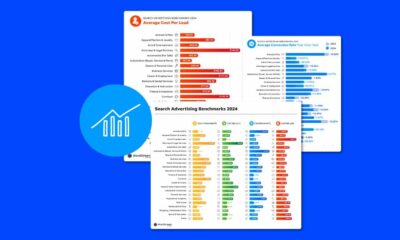









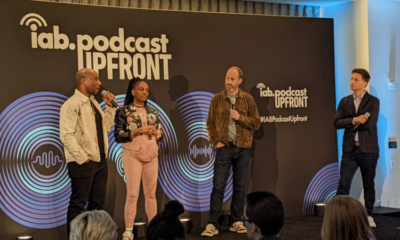



You must be logged in to post a comment Login